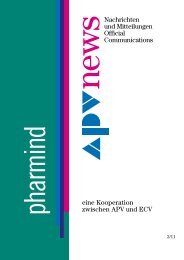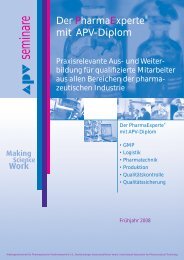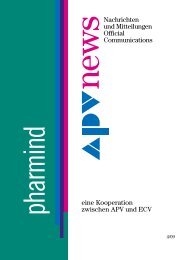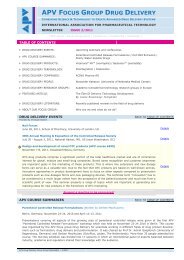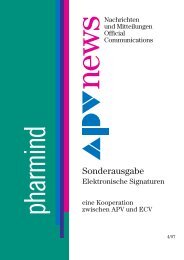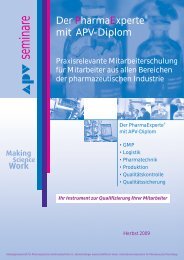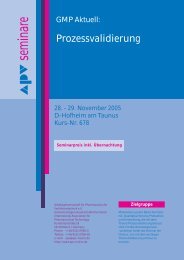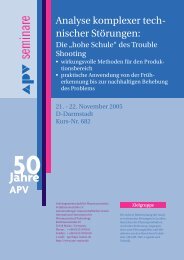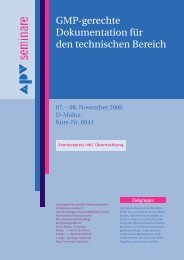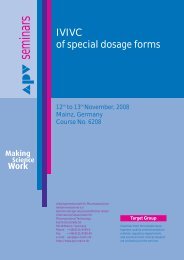APV FOCUS GROUP DRUG DELIVERY
APV FOCUS GROUP DRUG DELIVERY
APV FOCUS GROUP DRUG DELIVERY
Create successful ePaper yourself
Turn your PDF publications into a flip-book with our unique Google optimized e-Paper software.
Generally, there are nine standard process elements in transdermal manufacture which correspond to different<br />
production phases:<br />
1. Processes for the API, its particle structure and its potential embedding in pre-processed coatings, complexes or<br />
aggregates<br />
2. Processes to dissolve essential individual excipients like polymers<br />
3. Manufacture of the coatable / spreadable mass(es), with or without API<br />
4. Coating and drying<br />
5. Lamination processes<br />
6. Slitting<br />
7. Converting<br />
8. Primary packaging<br />
9. Secondary packaging<br />
Despite in later phases being continuous by design, transdermal processes are batch-driven as it is difficult to produce<br />
the spreadable mass containing the API in a homogenous, continuous fashion. If laminates with different<br />
drug-containing layers are used, it is common to define the layer with the highest drug content as batch-defining.<br />
2. History<br />
“Emplastra” were in a very simple sense the predecessors of transdermal therapeutic systems. They were first produced<br />
in ancient times (Egypt, Greece, Rome, and mediaeval times in Europe). Late in the 19 th century, these traditional<br />
formulae were first "industrialized" by means of "drug in adhesive" continuous spreading and solidification processes.<br />
Between about 1890 and 1960, these products fell out of fashion and in consequence the underlying processes were<br />
also forgotten apart from a few exceptions.<br />
Alza's re-invention of topical and systemic transdermal therapy began with a combination of a reservoir with a<br />
controlling membrane layer in a patch. This concept was considered both new (compared to previous systems) and<br />
simple (involved simple lamination processes). It dominated production and design technology between 1970 and 1990.<br />
Most systems during this period were produced by combining / laminating drug-free laminates of industrial adhesive<br />
layers (available as commodities) with foil-like membranes. Initially only liquid-containing, sealed reservoirs of the drug<br />
ingredient were generated e.g. in the case of Estraderm ® , the first hormone patch. In other examples, the active<br />
ingredient was dissolved or dispersed in a layered reservoir structure which was quite often devoid of adequate adhesive<br />
characteristics. In all these processes, no large investments in coating and drying equipment were necessary and<br />
production lines could be kept simple and comparatively small. However, these patches had some disadvantages in<br />
terms of visual appearance and/or performance.<br />
With the introduction of the first matrix (drug in adhesive) systems in the 1980s and 1990s (e.g. Nitro-Dur ® , Deponit ®<br />
for nitroglycerin, Systen ® , Fem7 ® , Dermestril ® for estradiol), systems became more flexible and consumer-friendly and,<br />
due to the omission of restricting membranes, drug utilization increased with reduced patch size. These technologies<br />
were in many cases initially created and honed in the hands of medical adhesive makers like Nitto, 3M, Beiersdorf and<br />
Lohmann. Skilled owners and operators of pre-existing industrial process lines for coating, drying and laminating on a<br />
large scale converted them into pharma lines. This process is still going on.<br />
3. Established standard process sequence<br />
According to ”Quality by Design” principles, the formulation should get more rugged to the peculiarities and challenges<br />
of the process. However, in the case of transdermal formulations, innovative developers tend to add new risk factors<br />
(like the addition of volatile enhancers, phase borders, polymer blends and borderline saturation status of the API)<br />
rather than reduce them. This is the unique challenge of formulation in conjunction with process design and requires a<br />
high degree of interdisciplinary thinking. Most transdermal formulations contain the API in solution, a state in which it<br />
must reliably remain during the entire shelf life of the product. However, there have been cases where under certain<br />
storage conditions, re-crystallisation of the active ingredient occurred. This issue can be avoided by the performance of<br />
adequate solubility studies in the full knowledge that polymers tend to super-saturate any monomeric compound quite<br />
efficiently. Less known is the fact that re-crystallisation may even occur in the case of solid drug dispersions in the<br />
formulation. Like in ointments, there is a tendency for larger crystals to grow and smaller particles to shrink due to<br />
dissolution. The best and most sensible method to monitor for changes of this kind are in-vitro release profile tests.<br />
Nowadays most polymers are available ready dissolved in organic solutions. Despite this it may be advisable for the<br />
drug delivery manufacturing companies to carry out polymer dissolution as this gives better process control and more<br />
flexibility in switching pharmacopoeial solvent quality. However, novices in this technology will be surprised as to the<br />
many mistakes that can be made which extend polymer dissolution time unnecessarily. In order to dissolve, for<br />
example, polyisobutylene (PIB) or synthetic rubber, it is first necessary to generate freshly calendered-flat sheets as<br />
these enable even access of solvent to the polymer during the dissolution process. Further processing has to be done in<br />
<strong>APV</strong> Drug Delivery Focus Group Newsletter – 3/2011 Page 9 of 14



